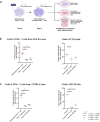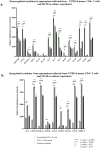Cancer cells accelerate exhaustion of persistently activated mouse CD4+ T cells
- PMID: 40536473
- PMCID: PMC12184148
- DOI: 10.1080/2162402X.2025.2521392
Cancer cells accelerate exhaustion of persistently activated mouse CD4+ T cells
Abstract
Most exhaustion studies have focused on CD8+ T cells. Here, we demonstrated reciprocal growth inhibition of CD4+ T cells and colorectal cancer cells, which induced the expression of PD-1, PD-L1, and PD-L2 in CD4+ T cells. The accelerated exhaustion of CD4+ T cells was evidenced by the reduced secretion of several cytokines, including IL-2, IFN-γ, or TNFα, and elevated secretion of CXCL family chemokines. Progressive expression of PD-L1, CTLA4, and IDO1 exhaustion markers occurred concomitantly with tumor growth in vivo in a mouse model. The pattern of CD4+ T cell exhaustion was analogous to that observed in CD8+ T cells, although with altered dynamics. The PD-L1-high phenotype can be induced by co-culture with tumor cells and is mediated by secreted factors in addition to cell contact. Our findings revealed that IFN-γ receptor knockout T cells exhibited PD-L1 protein expression when cultured with tumor cells, suggesting that PD-L1 expression is not fully dependent on IFN-γ. The TIL population undergoing exhaustion due to persistent antigen stimulation in the presence of cancer cells gradually acquires an immunosuppressive phenotype. The accumulation of inhibitory signals exerted by both cancer cells and T cells, which had converted to a suppressive phenotype, accelerated T cell exhaustion.
Keywords: CD4+ T cell exhaustion; PD-L1 expression; mouse colorectal cancer cells.
Conflict of interest statement
No potential conflict of interest was reported by the author(s).
Figures






Similar articles
-
INHBA promotes tumor growth and induces resistance to PD-L1 blockade by suppressing IFN-γ signaling.Acta Pharmacol Sin. 2025 Feb;46(2):448-461. doi: 10.1038/s41401-024-01381-x. Epub 2024 Sep 2. Acta Pharmacol Sin. 2025. PMID: 39223366
-
The aryl hydrocarbon receptor controls IFN-γ-induced immune checkpoints PD-L1 and IDO via the JAK/STAT pathway in lung adenocarcinoma.J Immunol. 2025 Mar 1;214(3):413-432. doi: 10.1093/jimmun/vkae023. J Immunol. 2025. PMID: 40073102
-
The tetravalent, bispecific properties of FS118, an anti-LAG-3/PD-L1 antibody, mediate LAG-3 shedding from CD4 + and CD8 + tumor-infiltrating lymphocytes.Anticancer Drugs. 2025 Jul 1;36(6):447-458. doi: 10.1097/CAD.0000000000001705. Epub 2025 Mar 3. Anticancer Drugs. 2025. PMID: 39960386 Free PMC article.
-
PD-L1 diagnostic tests: a systematic literature review of scoring algorithms and test-validation metrics.Diagn Pathol. 2018 Feb 9;13(1):12. doi: 10.1186/s13000-018-0689-9. Diagn Pathol. 2018. PMID: 29426340 Free PMC article.
-
Nivolumab for adults with Hodgkin's lymphoma (a rapid review using the software RobotReviewer).Cochrane Database Syst Rev. 2018 Jul 12;7(7):CD012556. doi: 10.1002/14651858.CD012556.pub2. Cochrane Database Syst Rev. 2018. PMID: 30001476 Free PMC article.
References
-
- Taube JM, Anders R, Young GD, Xu H, Sharma R, McMiller TL, Chen S, Klein AP, Pardoll DM, Topalian SL. et al. Colocalization of inflammatory response with B7-H1 expression in human melanocytic lesions supports an adaptive resistance mechanism of immune escape. Sci Transl Med. 2012;4(127):1–22. doi: 10.1126/scitranslmed.3003689. - DOI - PMC - PubMed
MeSH terms
Substances
Grants and funding
LinkOut - more resources
Full Text Sources
Medical
Research Materials
